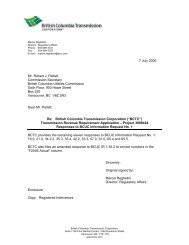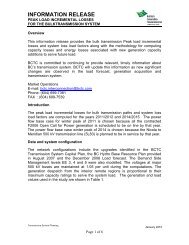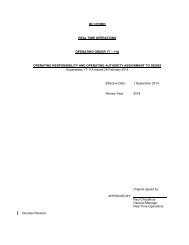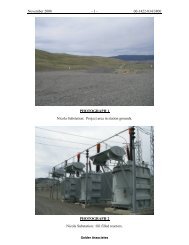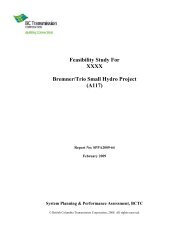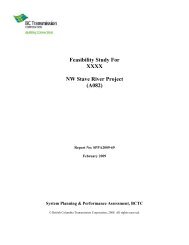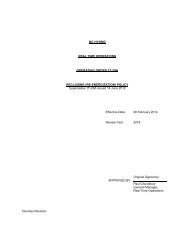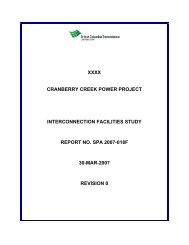Evidence on the Adequacy of First Nations Consultation - BC Hydro ...
Evidence on the Adequacy of First Nations Consultation - BC Hydro ...
Evidence on the Adequacy of First Nations Consultation - BC Hydro ...
You also want an ePaper? Increase the reach of your titles
YUMPU automatically turns print PDFs into web optimized ePapers that Google loves.
The Columbia Lakes moved down <strong>the</strong> Columbia River, past Kinbasket Lake and al<strong>on</strong>g Canoe River,<br />
<strong>the</strong>n up through <strong>the</strong> Yellow Head Pass ["Yakti.kL", = "foot print"], to east <strong>of</strong> <strong>the</strong> plains.<br />
Then <strong>the</strong>y moved south al<strong>on</strong>g east bench <strong>of</strong> <strong>the</strong> Rockies and returned by <strong>on</strong>e <strong>of</strong> <strong>the</strong> many passes,<br />
Vermilli<strong>on</strong>, Kicking Horse, Elk or Crow's Nest, etc., to <strong>the</strong> west side <strong>of</strong> <strong>the</strong> mountains.<br />
Chief Arbell also observed that <strong>the</strong> Columbia Lakes area had “no deer” [but] an abundance <strong>of</strong> elk,<br />
moose, goats and sheep. Paul David advised that “<strong>the</strong> T.P. [Tobacco Plains] and St. Mary’s Kutenai<br />
used to hunt moose and elk, as far north as Golden.” [Vol. V, p. 46]<br />
Schaeffer himself observed in a letter to his <strong>the</strong>sis advisor Dr. Wissler dated July 13, 1937 that “<strong>the</strong><br />
Windermere Kutenai” participated in <strong>the</strong> buffalo hunt to <strong>the</strong> extent that <strong>the</strong>y had horses, but noted<br />
that "...<strong>the</strong> veneer <strong>of</strong> Plains trait was very thin” [Vol. IX]. The Columbia Lakes people <strong>the</strong>refore had<br />
placed a str<strong>on</strong>g reliance <strong>on</strong> fishing and local game hunting for a very l<strong>on</strong>g time, c<strong>on</strong>sistent with this<br />
observati<strong>on</strong> in Schaeffer’s notes [Vol V, p. 50]:<br />
‘Lived near town <strong>of</strong> Fairm<strong>on</strong>t Springs and used <strong>the</strong>se springs for treating <strong>the</strong> sick in <strong>the</strong> old days...They<br />
hunted north al<strong>on</strong>g <strong>the</strong> Sillimacheen River (yaginasu.ke - "Red River", named from <strong>the</strong> blood <strong>of</strong> salm<strong>on</strong><br />
speared in this river)...<br />
Schaefer recorded that Eustace informed him about some <strong>of</strong> <strong>the</strong> seas<strong>on</strong>al round <strong>of</strong> <strong>the</strong> old qatmukinik<br />
people <strong>of</strong> Toby Creek, ancestors <strong>of</strong> <strong>the</strong> Columbia Lakes Ktunaxa:<br />
Katamu was a regular place <strong>on</strong> Toby Creek, at Columbia Lakes, where <strong>the</strong>se people secured <strong>the</strong>ir<br />
sec<strong>on</strong>d batch <strong>of</strong> salm<strong>on</strong>. Must have spent c<strong>on</strong>siderable time <strong>the</strong>re, since that name was given <strong>the</strong>m...<br />
At close <strong>of</strong> fishing ses<strong>on</strong>, <strong>the</strong> Katamukunek split up, some set out to hunt bis<strong>on</strong>, o<strong>the</strong>rs elk and at end <strong>of</strong><br />
seas<strong>on</strong> would meet to winter toge<strong>the</strong>r in <strong>the</strong> south. Some returned Katamu after New Year's, to spend<br />
<strong>the</strong> m<strong>on</strong>ths <strong>of</strong> January, February and March, hunting mountain sheep and wild fowl. Often Kutenai<br />
from Tobacco Plains joined <strong>the</strong>m, as game was plentiful <strong>the</strong>re...<br />
In his letter to Dr. Wissler, he also gives an indicati<strong>on</strong> <strong>of</strong> <strong>the</strong> impressive range <strong>of</strong> <strong>the</strong> Ktunaxa when<br />
he describes <strong>the</strong> area covered by <strong>the</strong> Michel Plains people:<br />
…[I]n additi<strong>on</strong> to <strong>the</strong> Columbia Lakes and Tobacco Plains groups, <strong>the</strong>re is left <strong>the</strong> group about Crow's<br />
Nest Pass (whom Teit called Tunaxa and claimed were living entirely east <strong>of</strong> <strong>the</strong> Divide). Strangely<br />
enough, I have been able to secure but little informati<strong>on</strong> <strong>on</strong> <strong>the</strong> latter group from informants here. The<br />
Chief told me <strong>the</strong> Tunaxa made a two year circuit <strong>of</strong> <strong>the</strong> regi<strong>on</strong>, fishing <strong>on</strong>e fall at Columbia Lakes,<br />
<strong>the</strong>n crossing <strong>the</strong> Rockies by Yellowhead Pass (near which is <strong>the</strong> Kutenai Parc menti<strong>on</strong>ed by Henry<br />
Thomps<strong>on</strong>, per your letter and which he c<strong>on</strong>firms) moving south al<strong>on</strong>g <strong>the</strong> mountains in search <strong>of</strong> bis<strong>on</strong><br />
and recrossing again at North Kootenay Pass, and even as far south as Missoula, and <strong>the</strong>n coming north<br />
to Tobacco Plains. This route refers to period after introducti<strong>on</strong> <strong>of</strong> <strong>the</strong> horse, it being ra<strong>the</strong>r improbable<br />
that such a territory could be covered <strong>on</strong> foot in that length <strong>of</strong> time...<br />
Clearly <strong>the</strong> Ktunaxa had a heavy dependence <strong>on</strong> fish and game in <strong>the</strong> upper Columbia Valley, but<br />
Schaeffer reports a deep sadness in his informants at <strong>the</strong> passing <strong>of</strong> this richness, expressed in a<br />
poignant statement to him by Francais Adam Vol. VII, p. 3]:<br />
Nowadays <strong>the</strong> Kutenai get insufficient fish and game and believe that <strong>the</strong>y may undergo a physical<br />
deteriorati<strong>on</strong>, similar to that <strong>of</strong> white foods when spoiling or rotting.<br />
There appears very little in Schaeffer’s notes c<strong>on</strong>cerning relati<strong>on</strong>s <strong>of</strong> <strong>the</strong> Upper Ktunuxa with <strong>the</strong><br />
37<br />
Page 181 <strong>of</strong> 200






